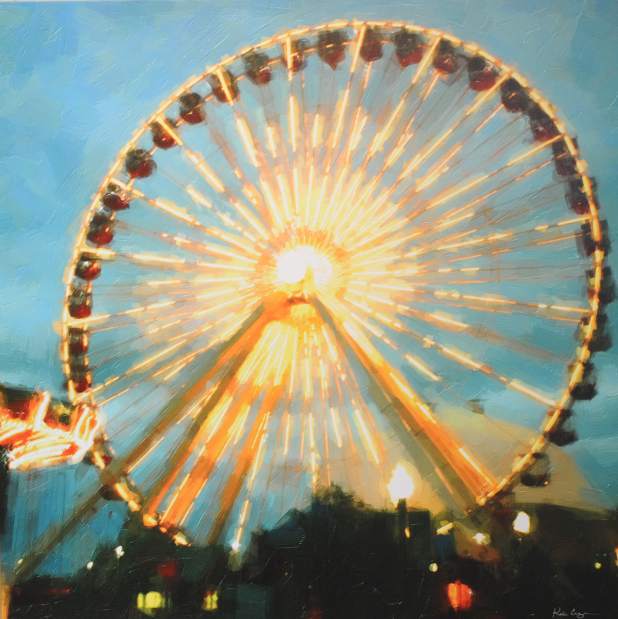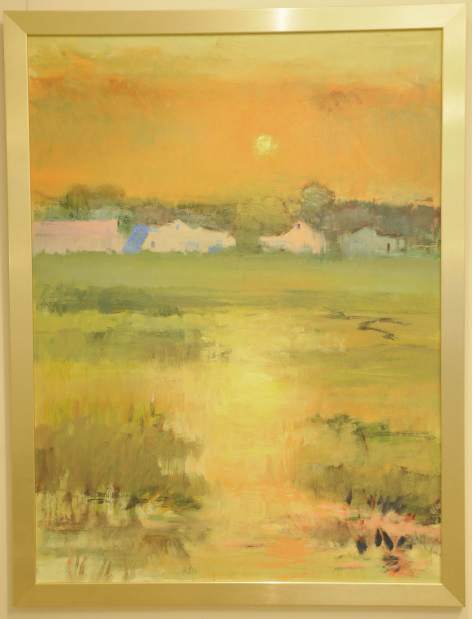Artists take impressionistic look at Pittsburgh
Paris may have been the subject of many impressionist paintings created over a century ago, but a new exhibit at Point Park University's Lawrence Hall proves that Pittsburgh, too, leaves quite an impression.
“Pittsburgh Impressionism: Past, Present, Future” features the works of three Pittsburgh-area artists — Philip Salvato, Kim Curinga and the late Frank DeAndrea — who present the city and its surroundings in an impressionist light.
Take, for example, the work of DeAndrea of Fox Chapel, who died in 2006.
The city's waterways and steel mills were a favorite subject of the artist, says his son, Mark DeAndrea of Scott.
“An oil painter, he would work on four or five different paintings at the same time, all at various stages of development,” DeAndrea says. “There'd be a whole room filled with canvases and hundreds of Polaroids referencing current and future work.”
Here, paintings like “Barge on the River” and “View from Washington's Landing” showcase Pittsburgh's magnificent waterways, with an emphasis on the effects of natural light as it cascades over the landscape.
“His favorite style was impressionism and favorite artist, Monet,” DeAndrea says. “He was pretty fast and could turn around a large painting in a couple of days.”
“A perfectionist,” DeAndrea says of his father: He remembers how his father would be commissioned for a painting, complete it, deliver it and then reappear a few days later at the buyer's house for some touch ups. “The painting was never done, in his mind.”
Carnegie artist Philip Salvato also has taken to painting in an impressionistic style, particularly outside, or as the French refer to it, en plein air.
For example, his oil-on-canvas “Carnegie Rooftops” was painted en plein air in one session.
“The painting was painted as a theoretical process,” he says, “meaning, I'll think of a way to paint it first, then apply the thought process.”
This particular work was painted using just three colors, in addition to white — manganese violet, thalo green and a warm ochre. “The thought was to use these colors and achieve some satisfying aesthetic result,” Salvato says. “In this case, I feel it happened.”
It's an exciting, albeit relaxing image.
“If my thoughts were to paint a lovely painting for sale, for sure, it would have failed,” Salvato says. “When thinking of an approach toward a painting, and painting through the thinking process or approach, I find it to be much more fun and a joy to see the theoretical process unfold.”
Much larger, the painting “Independence Marsh 2” is one of two works on display painted on site at Independence, Beaver County.
“Many times, I'll use the same spot and do something different,” Salvato says. “The darker painting was the first one, ‘Independence Marsh 1,' and the one more yellowish in hue, ‘Independence Marsh 2,' was the second.”
Here again, Salvato worked with a three-color system — Hansa yellow, alizarin crimson and ultramarine blue.
A vertically oriented work, “Independence Marsh 2” is different from the rest.
“I thought it would be interesting to paint it vertical,” Salvato says of his marshy subject. “Dawn and dusk are most interesting as far as light playing on form. It's my favorite time to paint, rather dramatic and rich in color.
Then, there is the work of Kim Curinga, a digital-photo artist from Nottingham, Washington County. She says her five pieces on display are based how she “feels” about her subjects.
For example, the rather dramatic piece “Asylum Window” is one of a series of photos taken at the Trans-Allegheny Lunatic Asylum in Weston, W.Va. Formerly known as the Weston State Hospital, this facility served as a sanctuary for the mentally ill in the mid-1800s.
“This is a favorite genre for me to shoot,” Curinga says. “Abandoned, decayed, etc.”
Made to look like a painting via the use of various filters in Photoshop, Curinga says, “When done as a painting, it goes from a gritty photograph, to more haunting and sad.
“I really like moody pieces,” she says. “Not everyone does, so I play the field with subject matter and style.”
A decidedly more upbeat image, “Ferris at Night” is a photo-painting of a Ferris wheel taken at the Historic Navy Pier in Chicago, even though, as Curinga recalls, “It was night and raining” when she took the initial shot.
“The photo as it was looked a little grainy, but done as a painting it took on an entirely different feel: It kind of glows,” she says.
Curinga says she likes to work with nighttime shots like this, because it highlights more “abstract” qualities in a landscape.
“When I like a photo, but not as it is, I'll work with it until it does stand on its own style,” she says. “I do what I like. And hope it strikes a chord with someone else.”
Kurt Shaw is the art critic for Trib Total Media. He can be reached at kshaw@tribweb.com.





